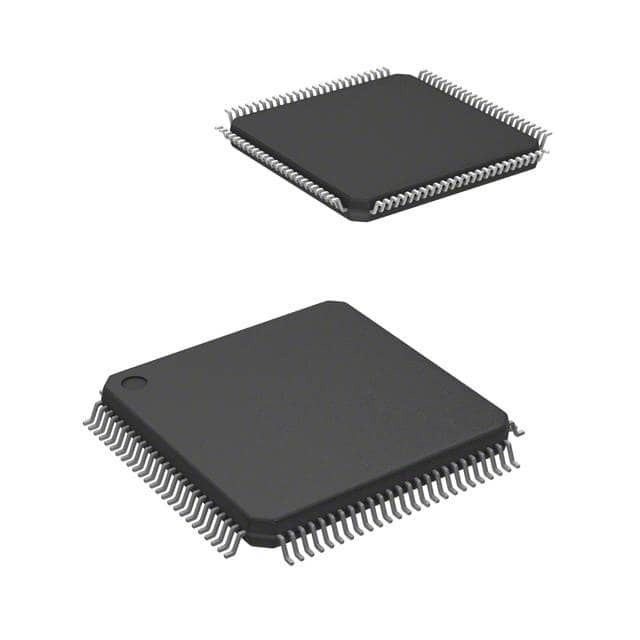MB96F645RBPMC-GSE2
Product Overview
Category: Microcontroller
Use: Embedded systems, IoT devices
Characteristics: High-performance, low-power consumption
Package: LQFP-100
Essence: Advanced microcontroller for various applications
Packaging/Quantity: Tray packaging, 250 units per tray
Specifications
- Architecture: CISC
- CPU Speed: 16 MHz
- Flash Memory: 64 KB
- RAM: 4 KB
- Operating Voltage: 2.7 V to 5.5 V
- Digital I/O Pins: 80
- Analog Input Channels: 8
- Communication Interfaces: UART, SPI, I2C
- Timers/Counters: 6
- ADC Resolution: 10-bit
- PWM Channels: 4
- Operating Temperature Range: -40°C to +85°C
Detailed Pin Configuration
The MB96F645RBPMC-GSE2 microcontroller has a total of 100 pins. The pin configuration is as follows:
- VDD
- P00
- P01
- P02
- P03
- P04
- P05
- P06
- P07
- P10
- P11
- P12
- P13
- P14
- P15
- P16
- P17
- P20
- P21
- P22
- P23
- P24
- P25
- P26
- P27
- P30
- P31
- P32
- P33
- P34
- P35
- P36
- P37
- P40
- P41
- P42
- P43
- P44
- P45
- P46
- P47
- P50
- P51
- P52
- P53
- P54
- P55
- P56
- P57
- P60
- P61
- P62
- P63
- P64
- P65
- P66
- P67
- P70
- P71
- P72
- P73
- P74
- P75
- P76
- P77
- P80
- P81
- P82
- P83
- P84
- P85
- P86
- P87
- P90
- P91
- P92
- P93
- P94
- P95
- P96
- P97
- RESET
- XTAL1
- XTAL2
- VSS
- AVDD
- AIN0
- AIN1
- AIN2
- AIN3
- AIN4
- AIN5
- AIN6
- AIN7
- VREF
- VSSA
- VDDA
- TEST
- TDO
- TDI
Functional Features
- High-performance CISC architecture for efficient processing
- Low-power consumption for extended battery life
- Ample flash memory and RAM for data storage and execution
- Wide operating voltage range for flexibility in power supply
- Multiple communication interfaces for seamless connectivity
- Timers/counters and PWM channels for precise timing and control
- High-resolution ADC for accurate analog measurements
Advantages and Disadvantages
Advantages: - High-performance capabilities - Low-power consumption - Ample memory resources - Versatile communication interfaces - Precise timing and control features
Disadvantages: - Limited number of I/O pins - Relatively high cost compared to some alternatives
Working Principles
The MB96F645RBPMC-GSE2 microcontroller operates based on a CISC architecture. It executes instructions stored in its flash memory, utilizing the CPU speed of 16 MHz. The microcontroller communicates with external devices through various interfaces such as UART, SPI, and I2C. It can perform analog measurements using its built-in ADC and generate PWM signals for controlling external components. The microcontroller's working principles revolve around efficient data processing, low-power operation, and reliable communication.
Detailed Application Field Plans
The MB96F645RBPMC-GSE2 microcontroller finds
Senaraikan 10 soalan dan jawapan biasa yang berkaitan dengan aplikasi MB96F645RBPMC-GSE2 dalam penyelesaian teknikal
Sure! Here are 10 common questions and answers related to the application of MB96F645RBPMC-GSE2 in technical solutions:
Q: What is MB96F645RBPMC-GSE2? A: MB96F645RBPMC-GSE2 is a microcontroller unit (MCU) developed by Fujitsu Semiconductor. It is designed for use in various technical solutions, offering advanced features and capabilities.
Q: What are the key features of MB96F645RBPMC-GSE2? A: Some key features of MB96F645RBPMC-GSE2 include a high-performance 16-bit CPU core, on-chip flash memory, multiple communication interfaces, analog-to-digital converters, timers, and various peripheral functions.
Q: In what applications can MB96F645RBPMC-GSE2 be used? A: MB96F645RBPMC-GSE2 can be used in a wide range of applications such as industrial automation, automotive systems, consumer electronics, medical devices, and more.
Q: How much flash memory does MB96F645RBPMC-GSE2 have? A: MB96F645RBPMC-GSE2 has a built-in flash memory with a capacity of XX kilobytes (KB). The exact capacity may vary depending on the specific variant of the MCU.
Q: What communication interfaces are available on MB96F645RBPMC-GSE2? A: MB96F645RBPMC-GSE2 provides various communication interfaces, including UART, I2C, SPI, CAN, LIN, and USB. These interfaces enable seamless connectivity with other devices or systems.
Q: Can MB96F645RBPMC-GSE2 support real-time operating systems (RTOS)? A: Yes, MB96F645RBPMC-GSE2 is capable of running real-time operating systems, making it suitable for applications that require precise timing and multitasking capabilities.
Q: Does MB96F645RBPMC-GSE2 have any analog-to-digital converters (ADC)? A: Yes, MB96F645RBPMC-GSE2 integrates multiple ADC channels, allowing the MCU to convert analog signals into digital data for processing or control purposes.
Q: What development tools are available for programming MB96F645RBPMC-GSE2? A: Fujitsu provides a comprehensive set of development tools, including an integrated development environment (IDE), compilers, debuggers, and programming software, to facilitate programming and debugging of MB96F645RBPMC-GSE2.
Q: Can MB96F645RBPMC-GSE2 operate in harsh environments? A: Yes, MB96F645RBPMC-GSE2 is designed to withstand harsh environmental conditions. It has a wide operating temperature range and offers robust protection against electrical noise and voltage fluctuations.
Q: Are there any application examples using MB96F645RBPMC-GSE2? A: Yes, some application examples include motor control systems, industrial automation controllers, automotive engine management systems, home appliances, and medical monitoring devices.
Please note that the specific details mentioned in the answers may vary depending on the actual specifications and documentation provided by Fujitsu Semiconductor for MB96F645RBPMC-GSE2.


